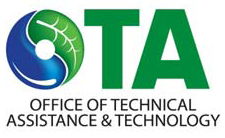
The end of the report contains a bibliography of existing resources covering state-of-the-art workplace good practices for nanoscale materials. The bibliography includes the “usual suspect” documents and websites published by NIOSH, ICON, German government, British Standards Institute, ED/DuPont, NanoSafe, and ASTM. From these primary sources, OTA distills a basic set of good practices for entities working with nanoscale materials in Massachusetts.
First, establish a risk reduction plan for facilities working with nanoscale materials. Such a plan should have two levels. First, it should attempt to protect against direct and immediate worker exposure. Second, it should also attempt to protect against possible releases during transport, use, and disposal after the nanoscale materials leave the manufacturing facility.
Second, evaluate potential worker exposure to nanoscale materials during the manufacturing process and then implement a hierarchy of exposure controls, including: substituting source materials with non-nano substances where appropriate, implementing engineering controls, using administrative controls, and requiring the use of personal protective equipment. This is all standard NIOSH-fare drawn from NIOSH’s excellent “Approaches to Safe Nanotechnology: Managing the Risks and Safety Concerns Associated with Engineered Nanoparticles.” OTA’s guidance document, however, does a good job of drawing out the most important “nuggets” of information from the NIOSH document in a few short pages.
Third, analyze whether unintentional release of nanoscale materials may occur with consumer use or disposal of the product. Along these lines, OTA recommends companies consider: labeling products as already suggested by BSI and the EU, warning potentially affected downstream users and others regarding potential EHS risks through the use of the Material Safety Data Sheets and other written warnings, complying with existing environmental laws such as the Toxic Substances Control Act, conducting an open and transparent risk and hazard testing regime for the product throughout its complete lifecycle, and recognizing that proactive prevention of EHS concerns is required for successful commercialization of nanotechnology.
In the end, OTA’s document is a helpful quick reference guide, but it does not cover any new ground or delve deeply into its existing source material. Businesses involved in nanomanufacturing should still consult the underlying source material cited in the document, as well as EHS and legal experts as necessary. Massachusetts should be commended, however, for putting out this basic guidance document and attempting to proactively address these issues.
This work is licensed under a Creative Commons Attribution-NonCommercial 3.0 Unported.
